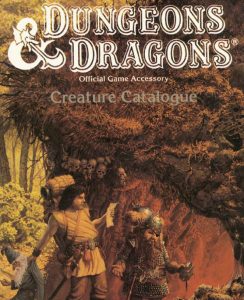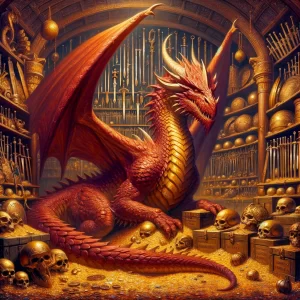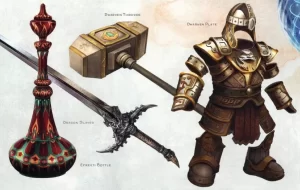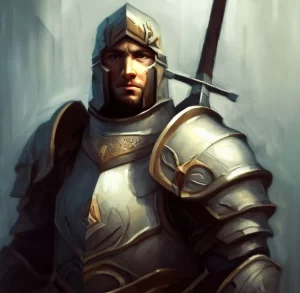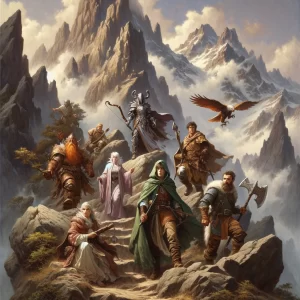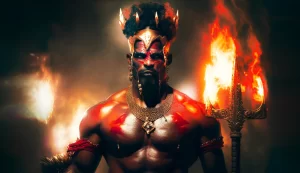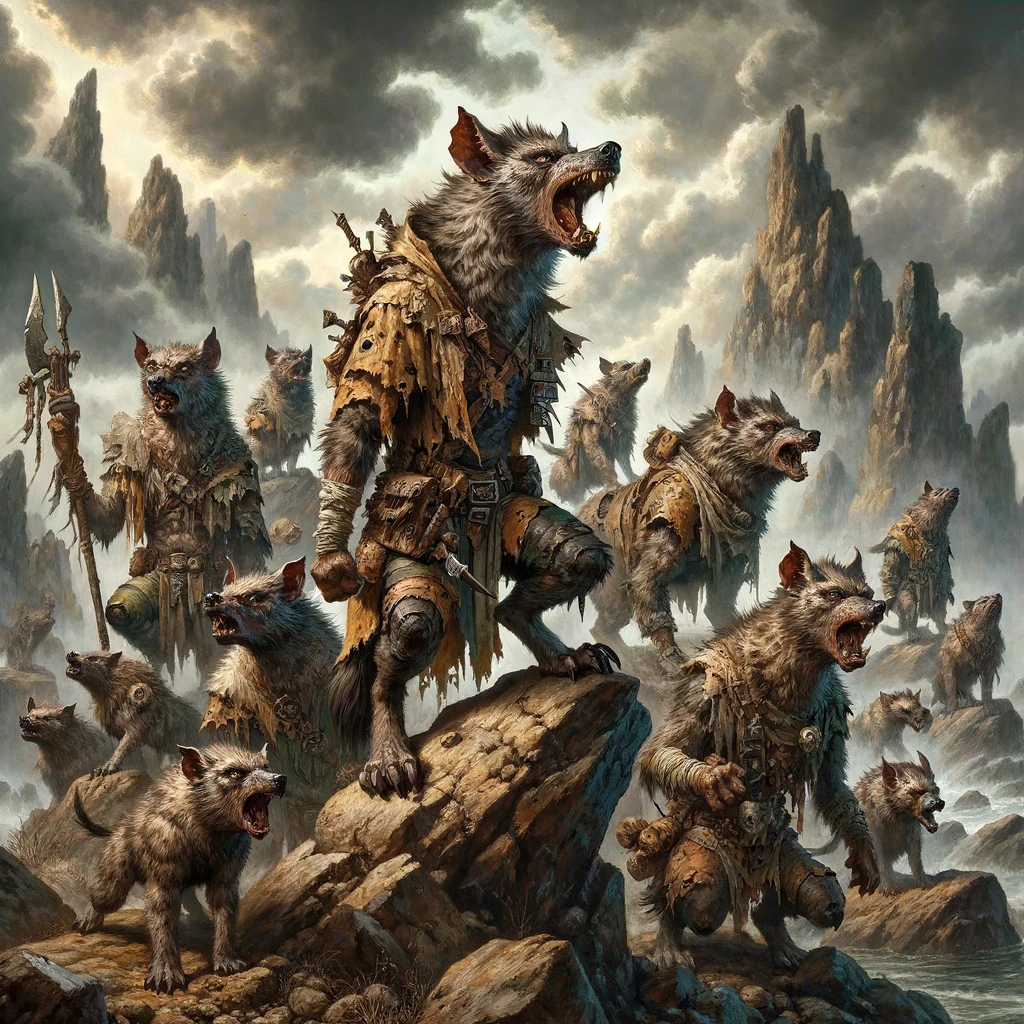
Gnolls, the savage hyena-like humanoids of the Dungeons & Dragons universe, harbor a sinister lineage that traces back to the malevolent whims of Yeenoghu, the demon lord of slaughter and savagery. Legend holds that the first gnolls were not born but made, transformed from ordinary hyenas that gorged themselves on the corpses left in Yeenoghu's wake during his rampages through the Material Plane. These beasts, bloated with the essence of carnage and demonic energy, rose on two legs, embodying the ferocity and cruelty of their patron. In grim rituals and through brutal acts, gnolls continue to venerate Yeenoghu, hoping to channel his destructive power and further their own bloody ends, forever linking their fate to his demonic legacy.
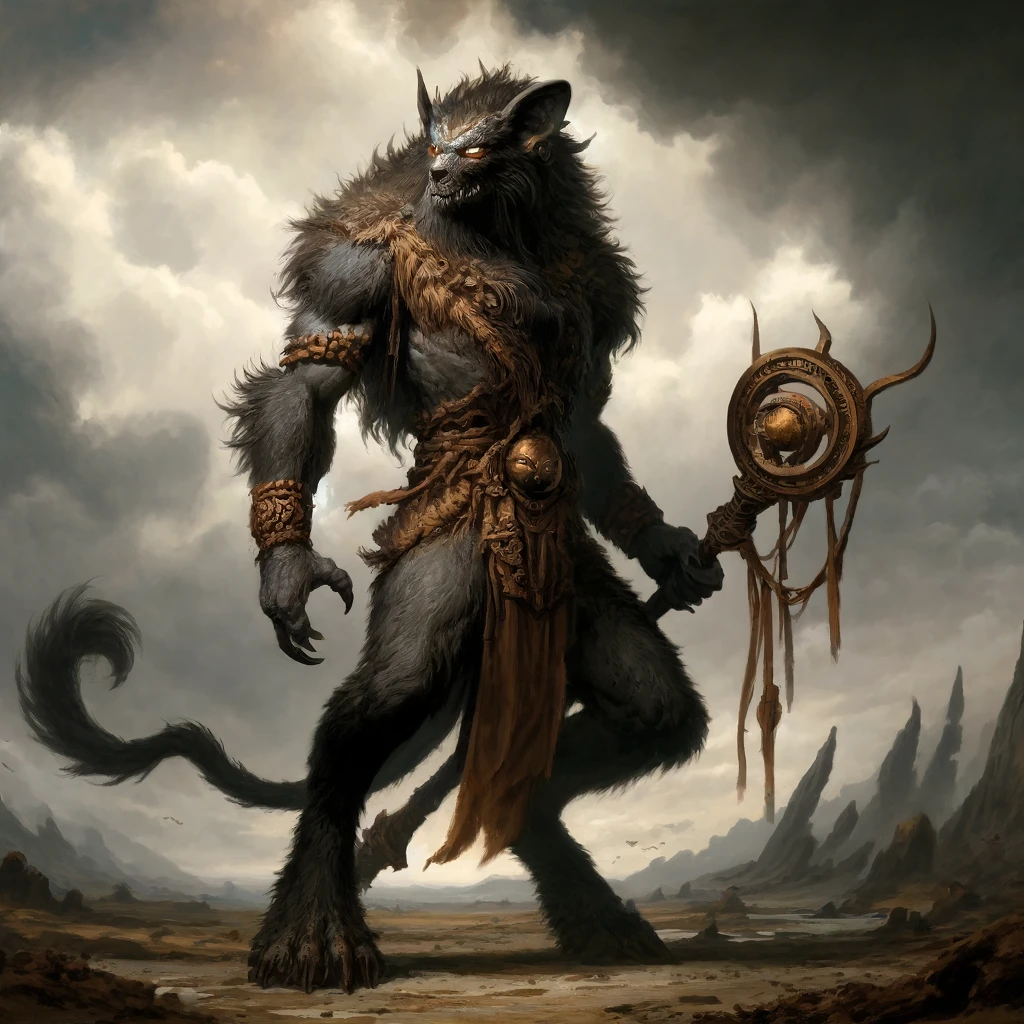
Every community that lacks walls to hide behind fears it; the cackling and whooping in the night which denotes a roving clan of gnolls. Settlements that have fallen to gnolls are easy to identify; they leave no bodies as evidence of their attack, even clumps of grass where blood has been spilled will be ripped up and devoured.
Gnolls craft nothing of their own; they subsist entirely on what they can take from others, and scavenging is the central pillar of gnoll culture. Gnolls have no currency, and don't place an inherent value on items beyond ownership; a tin cup a gnoll stole or took by force will have far more value to it than a whole chest of gold found by the wayside. Gnolls will typically keep a collection of items taken from their victims, sometimes coins or something similarly ubiquitous, but far more often body parts, with ears, hands, and scalps being the most common trophies.
To a gnoll, the clan is everything. Individuals may disagree, fight, or even kill each other, but the good of the clan comes before all else. While outward aggression is encouraged, subterfuge and betrayal are great taboos in gnoll society and incur the harshest punishments: more often than not, execution by ritual cannibalism. Children of the clan are raised communally, with most adult clan members contributing to their education and growth.
This innate need to be part of a clan means that gnoll pups raised amongst civilized races can become fiercely loyal to the 'parent' who raised them, though they will keep a vicious nature, and a desire to assert physical dominance. For this reason, gnoll clans are occasionally targeted by slavers, aiming to kill the adults and sell the pups to the highest bidder (generally for bodyguard or gladiatorial services), although this often ends badly for the slavers in question.
Shamans form the spiritual center of gnoll culture. Usually the oldest female, and often the mother of senior clan members, the shaman imparts the will of the gnoll gods to the clan, as well as performing rudimentary rituals and rites, including healing and simple divination, generally fueled by a great deal of blood. Many shamans possess abilities similar to lycanthropy: they can change form to that of a large hyena at will, allowing them to hunt with the pack and travel at speed. These abilities are the result of grisly rituals centered around the desecration of graves, and consumption of disinterred corpses, preferably those of notable virtue in life.
There are three distinct species of gnoll; the powerful and aggressive plains gnoll, the cowardly and opportunistic gutter gnoll, and the cunning and elusive rock gnoll.
The gnoll language is a mixture of low, guttural chatters and trumpeting hoots and wails which can carry great distances. Hyenas can understand Gnoll on a very basic level, a benefit of their shared ancestry. Gnoll is almost impossible to transcribe accurately, and attempts to do so cannot fully capture the nuances in tone and pitch which differentiate one call from another.
Examples of Gnoll Names: Aaonha, Drrell, Gorgg, Gruut, Haau'm, Meekau, Ooa'ri, Otuba, Rourt, Rrow'e, Skaa'bau, Yikitka, Zau'ki
Huge and powerfully built, even a subordinate male plains gnoll is larger than all but the most unusually massive humans, especially around the neck and hunched shoulders. They are covered in a coarse, short coat of blotchy ochre fur, with a scraggly, dark mane along the back of the neck. An unscarred plains gnoll is almost unheard of, as is one with full, unnotched ears; they constantly scrap amongst themselves and show barely more regard for each other than they do for their enemies.
As the largest variety, and therefore the most able to take on tough opponents, plains gnolls are often well-armed and armored, incorporating scraps of chainmail, even steel plate (generally rusted and not uncommonly stained with the blood of the previous owner) into their ragged hide clothing.
Forming huge clans numbering up to one hundred, plains gnolls can easily become the dominant monstrous species over a large area. Clan hierarchy is complex, strict and competitive, with those at the top being the most able to physically dominate those below. Females are larger, tougher and more aggressive, with the lowest female outranking the highest male. This lead some early, and perhaps somewhat misogynistic, scholars to suggest that plains gnolls were hermaphroditic, or could change sex at will (claims which have since been disproven, but remain prevalent in folklore). The clan seldom moves as a whole, unless defending territory from rivals or protecting the clan-mother, but small bands of three to ten will split off to range over the clan's territory.
Plains gnolls are infamous for their stamina and tenacity. Once they have selected their quarry, whether it be a merchant caravan or a military scouting party, they will pursue it relentlessly for days, weeks, even months, never dropping their considerable pace. This method of persistence hunting ensures that, unless the target turns and fights early on in proceedings, the gnolls will encounter a worn down, exhausted foe when combat is eventually forced. The only thing which will force a plains gnoll to abandon a chase is the taboo of passing into another clan's territory unannounced.
Plains gnolls favor open areas where they can see prey approaching from a distance, as well as build up good momentum for a chase. Due to their large size, they are not the stealthiest creatures, but will use the environment to their advantage. Long grass and gentle hills are the optimal conditions, allowing cover and elevation, without stopping the momentum of the charge.
They are not great builders, and are tough enough to withstand the elements. Where they make camp, the grass will be flattened in a rough circle as a communal area with higher status females commanding the center and the males on the periphery. Occasionally gnolls will settle briefly in the ruins of a settlement they have sacked, especially if there is more than the usual amount of plunder or corpses to devour. This may attract the attentions of other clans and, if there is food to spare, old rivalries are set aside temporarily. These periods of coming together are a time of ritual and mating and, rarely, a strong clan mother can unite the clans into a true horde.
The borders of a clan's territory are marked with effigies, usually no more than a stick topped with the painted skull of a venerated gnoll or hyena of the clan, for continuing to watch the borders after death is a great honor. At the center of each territory is a circle cleared of vegetation around a prominent landmark, such as an ancient stone circle or unusual outcrop, the raugra. Here, it is a great taboo to spill gnoll blood, and here is where the clan's shaman spends most of her days. Should a gnoll find themselves deep in another clan's territory and unable to retreat, they will find their way to the raugra. If they stay within the circle, they are safe and may be able to plead for leniency. If their pleas fall on deaf ears, as is often the case, they will usually be eaten alive as they try to flee.
It is rare for plains gnolls to speak Common, and the bits and pieces they may have picked up are limited in use, usually being desperate, pleading last words, and expletives. Even if they were fluent, however, plains gnolls have little interest in talking with other races. For one, they are, as a rule, distrustful of non-clanmembers, even among their own species. For another, plains gnolls are, not without reason, assured of their own physical abilities; as they see it, the only reason to talk to someone is to get things from them, and they are more than capable of getting those things from them without wasting time with talk.
Plains gnolls attack recklessly and wildly, seeking to spill as much blood as possible. Like many predators, they will work as a pack to split up their enemies and separate the weakest to surround and overwhelm. If the fight goes against them, the gnolls will signal a retreat but, unless their losses are severe, they will continue to pursue their quarry at a distance, trusting that their innate toughness will allow them to recover from their injuries before the weakened target can.
After a battle, the gnolls will squabble over the bodies for the right to loot and feed, with the exception of those brought down solely by one individual (these are claimed without argument). Weaker gnolls know better than to get involved, circling at the peripheries and thankful for whatever scraps they can snatch after the strongest have had their fill.
